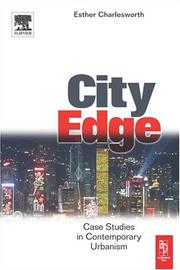| Listing 1 - 7 of 7 |
Sort by
|
Book
ISBN: 9780415818667 9780415818674 9781315776545 9781317690771 9781317690788 Year: 2014 Publisher: London Routledge
Abstract | Keywords | Export | Availability | Bookmark
 Loading...
Loading...Choose an application
- Reference Manager
- EndNote
- RefWorks (Direct export to RefWorks)
architectuur --- humanitaire interventies --- natuurrampen --- Architecture --- architecture [discipline] --- Development aid. Development cooperation --- Architectural practice --- Humanitarian assistance. --- Natural disasters. --- Architects --- Human factors. --- Moral and ethical aspects. --- Aide humanitaire --- Catastrophes naturelles --- Facteurs humains --- Pratique --- Aspect moral
Book
ISBN: 9780750668408 0750668407 Year: 2006 Publisher: London Elsevier
Abstract | Keywords | Export | Availability | Bookmark
 Loading...
Loading...Choose an application
- Reference Manager
- EndNote
- RefWorks (Direct export to RefWorks)

ISBN: 1136417192 1280629185 9786610629183 0080455875 9780080455877 9780750663533 0750663537 0750663537 9781136417191 9781136417146 1136417141 9781136417184 1136417184 9781138474116 1138474118 9781280629181 6610629188 Year: 2005 Publisher: Oxford Burlington, MA Architectural Press
Abstract | Keywords | Export | Availability | Bookmark
 Loading...
Loading...Choose an application
- Reference Manager
- EndNote
- RefWorks (Direct export to RefWorks)
This series of essays outlines a number of case studies from Europe, North America, Australia and Asia and provides first hand accounts of the experiences that planners, architects and politicians have had in reshaping cities. These insights provide a pragmatic assessment of the challenges and constraints posed by changing patterns of urban growth in a broad spectrum of urban environments. The reader will discover, through these multiple voices and views, the diverse forms of global cities, and will have a grasp of where the debate on urban design stands today, and where it may be going in the
City planning --- Land use, Urban --- Urban land use --- Cities and towns --- Urban economics --- Urban policy --- Urban renewal --- 711.4 --- 911.375.227 --- 911.375.227 Stadsregio. Urbanisatie --- Stadsregio. Urbanisatie --- 711.4 Gemeentelijke planologie. Stadsplanning. Stedenbouw --- Gemeentelijke planologie. Stadsplanning. Stedenbouw
Book
ISBN: 9780812241341 0812241347 0812206851 0812221958 1283897571 9781283897570 9780812206852 Year: 2009 Publisher: Philadelphia : University of Pennsylvania Press,
Abstract | Keywords | Export | Availability | Bookmark
 Loading...
Loading...Choose an application
- Reference Manager
- EndNote
- RefWorks (Direct export to RefWorks)
In Jerusalem, Israeli and Jordanian militias patrolled a fortified, impassable Green Line from 1948 until 1967. In Nicosia, two walls and a buffer zone have segregated Turkish and Greek Cypriots since 1963. In Belfast, "peaceline" barricades have separated working-class Catholics and Protestants since 1969. In Beirut, civil war from 1974 until 1990 turned a cosmopolitan city into a lethal patchwork of ethnic enclaves. In Mostar, the Croatian and Bosniak communities have occupied two autonomous sectors since 1993. These cities were not destined for partition by their social or political histories. They were partitioned by politicians, citizens, and engineers according to limited information, short-range plans, and often dubious motives. How did it happen? How can it be avoided?Divided Cities explores the logic of violent urban partition along ethnic lines-when it occurs, who supports it, what it costs, and why seemingly healthy cities succumb to it. Planning and conservation experts Jon Calame and Esther Charlesworth offer a warning beacon to a growing class of cities torn apart by ethnic rivals. Field-based investigations in Beirut, Belfast, Jerusalem, Mostar, and Nicosia are coupled with scholarly research to illuminate the history of urban dividing lines, the social impacts of physical partition, and the assorted professional responses to "self-imposed apartheid." Through interviews with people on both sides of a divide-residents, politicians, taxi drivers, built-environment professionals, cultural critics, and journalists-they compare the evolution of each urban partition along with its social impacts. The patterns that emerge support an assertion that division is a gradual, predictable, and avoidable occurrence that ultimately impedes intercommunal cooperation. With the voices of divided-city residents, updated partition maps, and previously unpublished photographs, Divided Cities illuminates the enormous costs of physical segregation.
City and town life. --- Persecution. --- Population transfers. --- Urban violence. --- Urban warfare. --- Beirut (Lebanon) --- Belfast (Northern Ireland) --- Jerusalem --- Mostar (Bosnia and Hercegovina) --- Nicosia (Cyprus) --- History. --- JERUSALEM -- 930.31
Book
ISBN: 1003097030 1003097030 1000813819 9781003097037 9781000813814 Year: 2023 Publisher: London, England : Routledge,
Abstract | Keywords | Export | Availability | Bookmark
 Loading...
Loading...Choose an application
- Reference Manager
- EndNote
- RefWorks (Direct export to RefWorks)
This book explores the themes of design and fragility and the nascent field of 'humanitarian architecture', analysing thirteen case studies of design responses to displacement, conflict and disaster.
Disaster relief --- Architecture --- Human factors
Book
ISBN: 9780812206852 Year: 2011 Publisher: Philadelphia
Abstract | Keywords | Export | Availability | Bookmark
 Loading...
Loading...Choose an application
- Reference Manager
- EndNote
- RefWorks (Direct export to RefWorks)
Multi
ISBN: 9780812206852 9780812221954 Year: 2011 Publisher: Philadelphia, Pa University of Pennsylvania Press
Abstract | Keywords | Export | Availability | Bookmark
 Loading...
Loading...Choose an application
- Reference Manager
- EndNote
- RefWorks (Direct export to RefWorks)
| Listing 1 - 7 of 7 |
Sort by
|

 Search
Search Feedback
Feedback About UniCat
About UniCat  Help
Help News
News